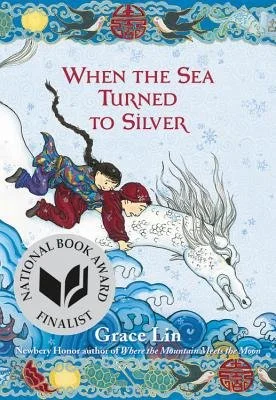Episode #145: Special Lunar New Year episode "The Legend of Buddha's Delight" storytime with Grace Lin!
Hello Everyone! Kids Ask Authors is back from the holiday break! I'm Grace Lin, children's book author and illustrator of many books, including the middle grade novel When the Sea Turned to Silver and the picture book A Big Moon Cake for Little Star.
Today I have a super special episode for you! To start off 2023 and to celebrate the Lunar New Year, we’re doing a special story time episode! Instead of answering kid questions like I usually do, today—in honor of the Lunar New Year—I thought I would share with you a legend of one of the foods we eat during this holiday.
Just in case you don’t know, the Lunar New Year is a very important Asian holiday! Many countries celebrate it—China, Korea, Japan, Taiwan and more! It is when the new year begins according to the moon calendar. The calendar that we use today is based on the sun but in ancient times, most people followed a calendar based on the moon. It was called the Lunar calendar. And when the year began according to that calendar it was called the Lunar New Year!
Now the story I am going to tell you is one of the many stories in my upcoming book Chinese Menu: The History, Myths, and Legends Behind Your Favorite Foods. The book doesn’t come out until sept 2023 so you are getting a sneak preview! The story I’m going to tell you is about a dish called Buddha’s Delight. Here’s an illustration from the book:
Buddha’s Delight
If you have eaten at a Chinese restaurant you have probably seen it listed on the menu, maybe under “vegetarian dishes.” Because Buddha’s Delight is a vegetarian dish! One of the teachings in Buddhism is not eating meat. So a dish of only vegetables stir-fried until tender in a savory brown sauce, would delight a Buddhist—hence the name of the dish. Buddha’s Delight is popular all over the world, finding its way into American Chinese restaurants in the 1960s and now served daily.
But, in China, people especially eat Buddha’s Delight at Lunar New Year. Some people eat it for good luck—because eating a dish that has not harmed a living being is a virtuous way to start the year, and such virtue will hopefully be rewarded! Others eat it as a way to return to healthier eating—after the rich, decadent feasting of Lunar New Year’s Eve, a dish of all vegetables is pretty good for your digestion. And of course, a lot of people eat it on Lunar New Year for both reasons!
There are many variations of Buddha’s Delight. At Lunar New Year, people make sure they include symbolic vegetables like bamboo shoots (representing new beginnings) or noodles (for long life). And nowadays, to make things easier, most people just have nine or ten ingredients. But the traditional recipe for Buddha’s Delight calls very specifically for eighteen ingredients. Why?
Well, it’s all explained by how Buddha’s Delight was created.
During the Song Dynasty, around 1120 CE, there was a Buddhist monastery in the city of Guangzhou. The Buddhist monks at this monastery were very devout and followed a strict schedule of meditation, prayer, work, and begging for alms.
Now, begging for alms—asking for donations of food—is an important part of being a Buddhist monk. Not only do the monks need food to survive but the monks believe their begging gives people a chance to do good deeds. And by doing good deeds, the monks believe that the givers will earn merit and will be blessed. To Buddhist monks, begging for alms is thought of as a circle of kindness.
So, one day, as according to their practice, the monks of the monastery dispersed to beg for alms. Six of the monks went east, toward the city. Another six monks went west, toward the village. The last six went south, toward the farmlands. But eventually all eighteen of them separated and walked alone, each carrying their begging bowls quietly.
The monks returned just as the sun began to arch overhead. While none of the bowls were empty, none of the bowls were full, either.
“In the city,” one of the monks who went east said, “we were given bamboo, bean threads, pressed tofu, fried wheat dumplings, dried black mushrooms, and pickled radish. But only a little of each.”
“In the village,” one of the monks who went west said, “we were given wood ear mushrooms, lotus root, golden needles, gingko nuts, bamboo shoots, and water chestnuts. But also, only a little of each.”
“The farmers gave us many things…,” said one of the monks who had gone south, “bean sprouts, celery, broccoli, peas, corn, and some cabbage. But, like all of you, a small amount of each.”
“Venerable friends,” another monk said, “it is obvious that none of us were given enough to make a meal for ourselves alone. However, if we combine what we were given, we may be able to make a dish that we can all share.”
The other monks quickly nodded in agreement. Together, they worked to slice and peel the vegetables, soak the dried food, and start the cooking fire. When all was ready, each put their collected food—all eighteen ingredients—into a heated pan with a little oil. As their food was cooking, one of the monks found some soy sauce and sesame oil to add as well.
And then it was done. As one of the monks let the mixture slide onto a large plate, all the monks breathed in the delicious, warm aroma—their eyes widening in surprised pleasure. In a matter of moments, the monks were devouring their portion like hungry oxen. When they finally finished, each looked up from their bowls at one another.
“That was delicious!” a monk exclaimed. “What good fortune that none of us were given enough to eat—it caused us to share our food and create this dish!”
The other monks smiled and laughed in agreement.
“Yes,” another monk said. “From now on, we shall always do this. We will put our donations
together to make and share this delight!” So they did. The dish became a daily meal at the monastery and soon other monasteries began to do the same. And not long after, the recipe found its way out into the villages, cities, and farms and all began to make and share the delicious Buddha’s Delight.
So that was the story of Buddha’s Delight! Like I said before, that is only one of the many stories in my upcoming book Chinese Menu. That book will tell the History, myths, and legends Behind Your Favorite Chinese Food—like the who General Tso of General Tso’s chicken is or the legend of how 4 competing dragons caused chow mein to be invented. It’s the fun and fascinating folklore of Chinese food and I am super excited for you to read it! Chinese Menu comes out in September 2023, you might even be able to pre-order it now.
But in the meantime, let’s end this episode with a kid book review!
Today’s Kid Book Review comes from Mina. Mina is reviewing, When the Sea Turns to Silver by Grace Lin.
My name is Mina, the book I would like to talk about is When the Sea Turned to Silver by Grace Lin. This book is about a girl named Pinmei and a boy named Yishan who try to save Pinmei's grandmother after she was captured by the emperor's soldiers. In order to save Pinmei's grandmother, they have to find a luminous stone that lights the night and bring it to the emperor. I like this book because it's not just a story, it is also a mystery. The mystery is Pinmei and Yishan have to find out what a luminous stone that lights the night really is. They find out that that is Lady Meng's tear which was very unexpected. I also like this book because the story is about Pinmei who is a Chinese girl like me.
Thank you Mina!
About Grace Lin:
Grace Lin, a NY Times bestselling author/ illustrator, won the Newbery Honor for Where the Mountain Meets the Moon and her picture book, A Big Mooncake for Little Star, was awarded the Caldecott Honor. Grace is an occasional commentator for New England Public Radio , a video essayist for PBS NewsHour (here & here), and the speaker of the popular TEDx talk, The Windows and Mirrors of Your Child’s Bookshelf. She is the co-host of the podcast Book Friends Forever, a kidlit podcast about friendship and publishing (geared for adults). Find her facebook, instagram , twitter ( @pacylin) or sign up for her author newsletter HERE.
Pre-Order "Once upon a Book" w/ Virtual Visit:https://shop.carlemuseum.org/once-upon-book-pre-order
All my books: https://shop.carlemuseum.org/category/books/autographed-books/grace-lin




